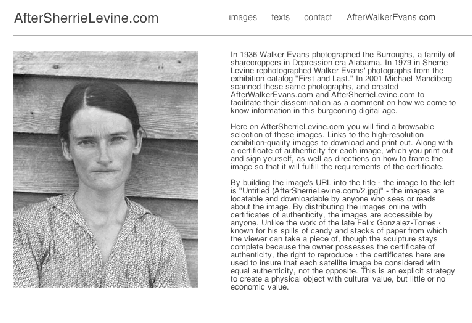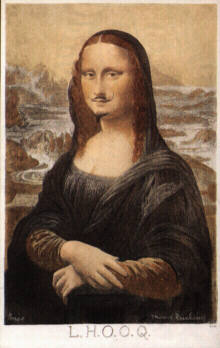|


Ressource :
levine.htm
doeringer/btlevine.html
Dürer/Mantegna
Albrecht Dürer., La Foi ,1495
Plume et encre brune. 197 x 108 mm.
Inscription à la plume et à l'encre brune au verso : Alberto Duro.
Filigrane italien : balance avec étoile.
Paris, BNF, Estampes, Rés. B 13
Marcel
Duchamp , LHOOQ , 1919

Picasso/Courbet
Pablo PICASSO
Les demoiselles du bord de la Seine d'après Courbet
1950
Huile sur contreplaqué
100,5 x 120,1 cm
Kunstmuseum, Bâle.
Jacquet/Manet
Alain JACQUET
Le déjeuner sur l'herbe
1964
Impression sur toile
173 x 96,8 cm
Australian National Gallery, Camberra.
Lavier/Eames
Bertrand Lavier, Charles Eames Peinte,
1991. Chaise moulée, peinture à l’huile. 81 x 62 x 55 cm.
Louise
Lawler/Richter/Duchamp
Nude , 2002_2003,cibachrome
Alys/Alberti
Francis Alÿs ,"From Alberti to The Thief.",1999
|
Copy ( Sherrie Levine )
Michael Mandiberg afterwalkerevans.com ,
aftersherrielevine.com
Description
· Le document montre 2 copies d'écran de 2 pages Internet .
Sur l'une comme sur l'autre , même image et même texte , sauf pour les adresses web des pages :
afterwalkerevans.com , aftersherrielevine.com
Donc 2 sites web en miroir .
· Le texte "légende" la photo de cette page et de fait
également les autres , qui sont accessibles par le lien "images " , comme étant des images scannées des célèbres photos de la famille Burroughs par
Walker Evans , photos de 1936 , présentées dans le catalogue de l'exposition "First and Last "
·Les clichés d'Evans ont été rendus célèbres par son livre "Let Us Now Praise Famous Men",
ouvrage avec des textes de James Agee) sur l'Amérique rurale pendant la Grande Dépression.
· Le texte mentionne aussi les images de Sherrie Levine , elles-mêmes rephotographiées à partir du même catalogue d'exposition .
" Mandiberg scanned these same photographs "
Levine est renommée pour "After Walker Evans", travail exposé à la Metro Pictures Gallery en 1981.
L'oeuvre est composée de photographies de Walker Evans, rephotographiées par Levine dans le catalogue cité et présentées en tant que telles.
· Le texte explique que l 'internaute peut télécharger les images et les imprimer en haute résolution .
Et qu'un certificat d'authenticité est fourni à chacun , pour chaque image , ainsi que la manière de l'encadrer .
Il illustre la valeur qui est accordée à ce certificat d'authenticité en se référant à
l'œuvre de Félix Gonzalez- Torres , où chaque spectateur pouvait prendre possession d'une pilule ou d'une page imprimée parmi toutes celles offertes à tous dans ces oeuvres .
(Untitled (Placebo), 1991, "Untitled" (Passport), 1991. "Untitled" (The End )
,1991)
· Le lien "images " permet de visualiser 22 photos scannées avec leur titre du type
, suivant le site le montre , " Untitled (AfterWalkerEvans.com/22.jpg)" ou bien
"Untitled (AfterSherrieLevine.com/9.jpg)" et les moyens de téléchargement indiqués plus haut .
· Un lien "contact" identifie l'artiste et renvoie à un autre site personnel à son nom ,
www.Mandiberg.com
, et un lien "texts" emmène à 4 textes :
- des notes de l'artiste sur l'art , citant entre autres Borges et
son "Pierre Menard, Author of the Quixote," the story of a man who rewrites the ninth and thirty-eight chapters of the Don
Quixote.
- une explication de l'artiste , se référant à Walter Benjamin," who explored the relationship of reproduction to artistic
authencity, the reproduction becomes the authentic experience.
Yet for Benjamin, reproduction destroyed the physical sacredness of the
object, and made it useful"
-une notice biographique sur Sherrie Levine
- 2 interviews-dialogues mettant en scène Sherrie Levine et en question son oeuvre .
Cette artiste qui se fit connaître
" in the early 1980s, when she was associated with Cindy Sherman, Robert Longo, David Salle and others known as "Appropriationists" for drawing on existing imagery from "high" and "low" culture".
Elle y dit :
"I like to think that all my work has some sort of aura of originality ."
"I do see my work as a head-on confrontation with the anxiety of
influence ."
"If they wanted image, they just take it. It was never an issue of morality; it was always issue of utility. There was no sense that images belonged to anybody; all images were in who the public domain and as an artist, I found that very liberating."
Et à propos de siècles plus
anciens :
" I think copies and prints were the main way of redistributing images at that time, before photography."
· Le document présenté ne permet pas de suivre ces liens , mais en mettant en vis à vis les 2 pages index des 2 sites , l'un citant Evans et l'autre citant Levine , il suffit à introduire le trouble sur la nature de 2 sites , sur l'authenticité de chacun et des images elles-mêmes , sur la reproduction de celles-ci et des sites eux-mêmes .
Quoique copies d'écran , le document suffit à indiquer la nature de l'œuvre
, une oeuvre pour l' Internet du "digital age" .
Notions dégagées :
· copie , reproduction , appropriation
- Mandiberg s'approprie la stratégie d 'appropriation de Levine .
- Il insiste sur les questions de droits d'auteur en fournissant les certificats d'authenticité .
On sait comment le web a relancé les questions de copyrights et de protection des oeuvres .
· valeur :
en permettant le téléchargement gratuit des images , Mandiberg met en avant leur valeur culturelle contre leur valeur marchande .
C'est une question posée sur l'art à l'époque d'Internet et de la dissémination des copies .
· Authenticité :
Alors que Levine posait déjà la question de l'authenticité , Mandiberg insiste en mettant en jeu la propre authenticité de son propre travail .
En s'appropriant les images, d'Evans , Levine soulevait déjà des questions sur les classes sociales , l'identité, l'utilisation politique de l'image, la nature de la créativité et la manière dont le contexte affecte la vue des photographies.
Mandiberg redouble ces questions , les relance par son utilisation du web , nouveau lieu de la diffusion de masse des images et de leur accessibilité .
Les 2 sites en miroir l'un de l'autre permettent de mettre en doute l'authenticité de l'image , son origine , sa valeur .
· Originalité : en rejouant le travail de Levine de 1981 , Mandiberg l'actualise à l'âge d'Internet .
Le spectateur a du mal a comprendre qui a fait quoi , doit le déchiffrer , et la question de l'originalité de l'œuvre d'art , et de la position de l'artiste se pose à lui
.
· Authenticité des images sur le web : forcément des reproductions , mais de quel original ?
"By
scanning this images, I am bringing her critique into the digital age:
one is increasingly likely to see (walker evans') images on a computer
screen, and not in a text book."
.Signature
· Image et texte :
pas de compréhension de l'image sans te texte
Ouvertures :
La circulation des oeuvres à la Renaissance : Dürer/Mantegna
les citations , reprises d'œuvres ,
reproductions :
Duchamp/De Vinci ,
Picasso/Courbet , Jacquet/Manet
Lavier/Eames ,
.la question de la monstration des
oeuvres , de leur exposition , du musée :
Louise Lawler , et Francis Alÿs pour ses
commentaires sur le web avec des images reproduites .
_______________________________________
|


